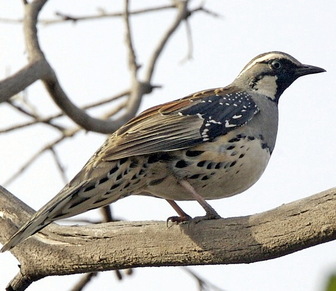Spotted Quail-thrush
Its natural habitat is subtropical or tropical dry forests.

Original source: Lip Kee YapPermission(Reusing this file)This image, which was originally posted to Flickr.com, was uploaded to Commons using Flickr upload bot on 21:39, 20 November 2008 (UTC) by Avala (talk). On that date it was licensed under the license below. This file is licensed under the Creative Commons Attribution-Share Alike 2.0 Generic license.You are free:to share – to copy, distribute and transmit the work
Author: Lip Kee YapPermission(Reusing this file)This image, which was originally posted to Flickr.com, was uploaded to Commons using Flickr upload bot on 21:39, 20 November 2008 (UTC) by Avala (talk). On that date it was licensed under the license below. This file is licensed under the Creative Commons Attribution-Share Alike 2.0 Generic license.You are free:to share – to copy, distribute and transmit the work
The Spotted Quail-thrush is classified as Least Concern. Does not qualify for a more at risk category. Widespread and abundant taxa are included in this category.
Physical characteristics: Spotted quail-thrushes range in length from 10.2 to 11 inches (26 to 28 centimeters), and weigh between 2.4 and 3.1 ounces (67 and 87 grams). Their plumage is a mottled blend of white, buff, rust or reddish brown, brown, and black. They have light brown heads with a white brow stripe. Their throats are black with a white patch, and their breasts are a pinkish tone. More
Spotted Quail-thrush (right) in wet eucalyptus forest of eastern Australia. This species has been declining with encroaching development. Males apparently sit up on logs to check out the surroundings, but if disturbed will usually flush, quail-like, on short whirring wings, showing prominent white tail tips as they depart (Morcombe 2000). They are often best located by voice, a high-pitched note that can be hard for some to hear (Simpson & Day 1996). More
the Spotted Quail-thrush is possibly extinct. The whipbirds and wedgebills are all found in Australia, occurring in a range of habitats from rainforest to arid scrub. The Western Whipbird is considered to be Near-threatened because of habitat loss and fires while the Papuan Whipbird is classed as Data Deficient. Behaviour - Chestnut-backed Quail-thrush (Cinclosoma castanotum) They are terrestrial birds which fly fairly weakly and prefer to squat or run when disturbed. More
The Spotted Quail-thrush (Cinclosoma punctatum) is a species of bird in the Cinclosomatidae family. It is endemic to Australia. Its natural habitat is subtropical or tropical dry forests. Search Wikimedia Commons Wikimedia Commons has media related to: Cinclosoma punctatum Search Wikispecies Wikispecies has information related to: Cinclosoma punctatum References - * BirdLife International 2004. Cinclosoma punctatum. More
Spotted Quail-thrush at Shoalhaven Gorge Yesterday, I went to Tallong, looking for Orchids, and found, instead a Spotted Quail-thrush walking around the middle of the road. This was on the road in to Long Nose Point, where there is a dramatic viewing point, overlooking the Shoalhaven Gorge, on the edge of the Morton National Park. This is close to Bungonia gorge, but that place is visible from the next viewing point, at Badgery's Lookout. More
The Spotted Quail-thrush is usually seen singly or in twos and, occasionally, in small family groups of up to five birds. It is an unobtrusive, shy and elusive species, seldom allowing a close approach by an observer; it usually keeps its back towards the observer while walking stealthily away into cover. Foraging birds are usually seen moving over leaf-litter on the forest floor, with a slow, meandering walk, a crouching run, or walking or running over or among rocks and fallen timber. More
The Spotted Quail-thrush (Cinclosoma punctatum) is a species of bird in the Cinclosomatidae family. George Shaw ( December 10, 1751 - July 22, 1813) was an English Botanist and Zoologist. Birds ( class Aves) are bipedal endothermic ( Warm-blooded) Vertebrate animals that lay eggs. The family Cinclosomatidae contains 9 Species of Passerine bird including the 3 whipbirds 2 wedgebills and the quail-thrushes It is endemic to Australia. More
The past range of Spotted Quail-thrush (Mt Lofty Ranges) was Mt Lofty Ranges, SA, as far north as Angaston, and at least as far south as Mt Compass. There have been no published records of Spotted Quail-thrush (Mt Lofty Ranges) since 1984. It is not listed under the EPBC Act or South Australian legislation. 3. How judged by TSSC in relation to the EPBC Act criteria. - TSSC judges the species to be eligible for listing as critically endangered under the EPBC Act. More
Keep an eye out for Spotted Quail-thrush on the ground and Koala in the trees. Take the fork to the left at 1.6 km from the Beechworth Rd. Half a kilometre later you come to the Mt. Pilot car park. A short walk leads to the fire-tower on the summit with spectacular views across the Murray Valley plains to the north. Common birds in the woodland here include Scarlet Robin, White- throated Treecreeper, Spotted Pardalote and Buff-rumped Thornbill. More
Family : Cinclosomatidae
Genus : Cinclosoma
Species : punctatum
Authority : (Shaw, 1794)
